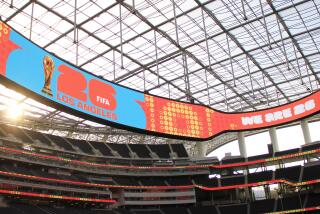Festival Logo: Colorful, but What Does It Mean? : Design: Director Peter Sellars wanted something with ‘the feeling of a modern cave painting.’
The new logo the Los Angeles Festival unveiled Thursday seems simple enough:
An almost shapeless white figure stands in the center of a globe-like circle, arms reach up to the sky, all four limbs touch the corners of the sphere in earth-tone colors.
But what does this symbol that will represent the festival on T-shirts, banners, posters and brochures throughout the summer really mean?
Take another look at the logo illustrated on Page F1; it’s open for deeper interpretation. According to designers from 2D3D and Gormly/Takeii design group, those simple lines say something about the festival’s entire feeling.
“The participation of the viewer is a major part of the festival,” said Jonathan Louie, a designer with 2D3D, which was chosen by festival organizers to create the official logo. “And that participation starts with the logo.”
As L.A. Festival Director Peter Sellars views the logo, “It’s open, like the festival. No two people will see it the same way.”
The two young designers, selected by Sellars and his staff from five Los Angeles design groups who were finalists, revealed some keys to interpretation:
“The round shape means it’s universal,” said Marika van Adelsberg, Louie’s creative partner. “The figure gives it a human quality. The open palms signify a spirituality. The dots on the top open into a rainbow. The whole thing has an organic shape, a warm feeling.”
Even the colors the designers chose have an “ancient feel. (They) are very rich and they convey a sense of cultures with the Indonesian blue and the Asian red,” Van Adelsberg said.
Sellars had given the design team some instructions about incorporating ancient symbols in the logo. “He kept saying we should make something with the feeling of a modern cave painting,” Van Adelsberg.
Where the heart should be in the middle of the figure is a black spiral to evoke a feeling of movement. As Louie sees it, “From the heart, that spiral, the person is reaching out to the four corners of the world, which gets across the idea that the festival is a sharing of cultures.”
Sellars is hesitant to give his interpretation of the logo. “It eludes description,” he said. “This isn’t a ‘Batman’-like presentation. You can’t boil it down. But I would say it gives off a feeling of multiplicity as a subject matter.”
Because of a long creative process involved in making a logo festival organizers were happy with, the logo arrived late in the game. But Sellars said he doesn’t think the tardiness of the logo is a “big issue,” nor is he embarrassed about it. “I’m relieved we didn’t force it,” he said, adding that he’s pleased with the result.
Louie and Van Adelsberg are not as pleased. “We had to compromise in many degrees. It’s not what we would have done, but it’s what they wanted,” Van Adelsberg said.
Will the logo be around for years?
“We’ll have to see,” Sellars said. “As we go into the ‘90s, we might want something different.”
More to Read
The biggest entertainment stories
Get our big stories about Hollywood, film, television, music, arts, culture and more right in your inbox as soon as they publish.
You may occasionally receive promotional content from the Los Angeles Times.










